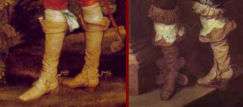Boothose
Boothose (boot-hose, boot hose) are over-stockings or boot liners worn in the sixteenth and seventeenth centuries to protect fine knitted stockings from wear. They first appear around 1450.[1]

Originally a practical item, they were later made of fine linen and sported elaborate lace and embroidered boothose tops.[1][2] By 1583 Philip Stubbs in his Anatomie of Abuses could decry "The vain excesse of botehosen"
...they must be wrought [embroidered] all ouer, from the gartering place vpward, with nedle worke, clogged with silk of all colors, with birds, foules, beasts, and antiques purtrayed all ouer in comlie sorte. So that I haue knowen the very nedle work of some one payre of these bootehose to stand, some in .iiij. pound, vi. pound, and some in x. pound a péece.[3]
In the 17th century, linen boothose could be trimmed with lavish lace tops turned down over cuffed bucket-topped boots.[4] In mid-century, it was briefly stylish to wear boothose with low-cut shoes, before boothose fell completely out of fashion. They lingered, once again a practical object, under the name boot stockings into the 18th century.[1]
See also
- 1600–1650 in fashion
- 1650–1700 in fashion
References
- Cumming, Valerie; Cunnington, C. W.; Cunnington, P. E. (2010-11-15). The Dictionary of Fashion History. Oxford ; New York: Bloomsbury Academic. p. 26. ISBN 9781847885333.
- Spufford, Margaret; Mee, Susan (2018-01-02). The Clothing of the Common Sort, 1570-1700. Pasold Studies in Textile History. Oxford, New York: Oxford University Press. p. 263. ISBN 978-0-19-880704-9.
- Stubbes, Philip. "The Anatomie of Abuses". University of Oxford Text Archive. Retrieved 5 February 2018.
- Gordenker, Emilie E. S. (2002-02-27). Van Dyck and the Representation of Dress in Seventeenth-Century Portraiture. Turnhout, Belgium: Brepols Publishers. p. 83. ISBN 978-2-503-50880-1.
- Ribeiro, Aileen: Fashion and Fiction: Dress in Art and Literature in Stuart England, Yale, 2005, ISBN 0-300-10999-7
